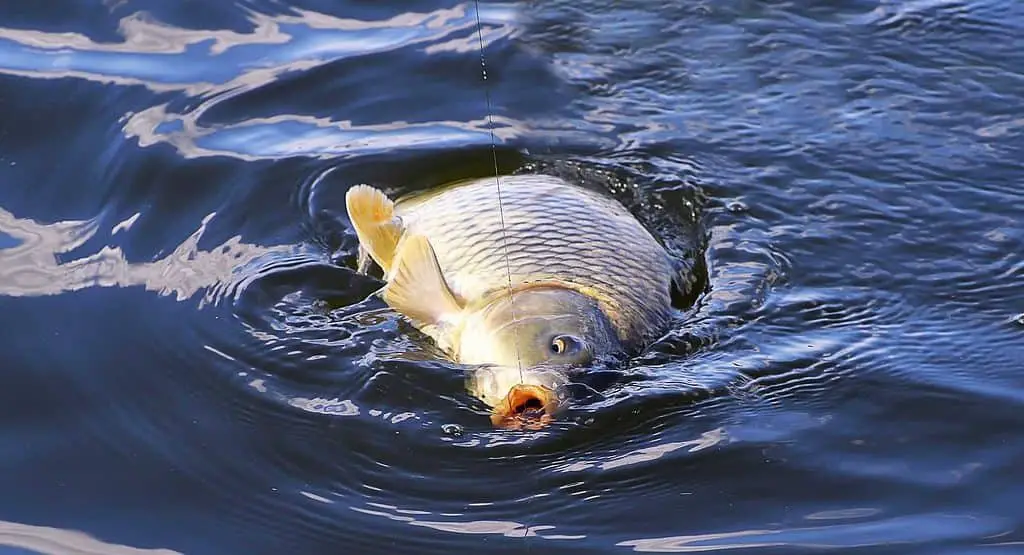Disclosure: Some posts contain affiliate links, which earn us a commission if you make a purchase through them. Positive Fishing © participates in various affiliate networks including the Amazon Services LLC Associates Program.
Using braided fishing line is banned by some fisheries due to concerns about fish being damaged or killed. There is little evidence to support braid causing this or in fact, being any worse than monofilament or fluorocarbon line use. However, more and more angling clubs and fisheries are banning braid.
There is some fear and falsehood in statements regarding the reported damage to fish, which has elevated in recent years. This has led to many fisheries amending their rules and banning braid completely as a hooklength and as a mainline.
Read more below to understand this subject in more depth.
What Injuries To Fish Have Been Reported?
Most cases fall into three categories:
- Damage to the mouth or lips.
- Small damage to scales or the body of the fish
- Fish gill areas are cut or gashed so severely that they die.
In the first category, it is claimed that short braid hooklengths can tear into the fish while hooking or fighting the fish. In certain cases, using the incorrect braid is the cause.
In the second category, it has been reported that the mainline wraps around the fish while the angler is landing and fighting the fish and rubs into the fish’s body.
The third category is the most severe, caused again by the line “wrapping” around the fish while playing and landing the fish, and this scenario is the highest concern.
What Is The Main Causes Of Damage?
For the first category, there are a lot of possibilities and theories from the angling community. First of all, is the damage caused by the line (any line, not just braid) or by the hooks? The subject of hooks damaging fish mouths and lips has been debated for more years than the braid concerns!
The use of barbed, micro-barbed, or barbless hooks is a minefield, with little scientific evidence on what is best. In addition to the choice of hooks used, there is also the fact that some anglers are not careful enough when unhooking the fish once it is caught.
The main suspect in the second and third scenarios is the angler himself. Braid is not easy to use and requires some skills. The theory is that the angler is being too aggressive with the fish when fighting the fish before landing. Braid has no stretch and is strong, so the angler can “bully” the fish more. Basically, there is less feeling of resistance to the angler through the line.
However, during the fight, fish will roll up in the line equally when using any type of mainline. Short hooklengths are the cause of this, not the line.

mouth is a best practice
Banned or Not Banned?
Angling clubs specify members’ rules for their specific fishing waters and must be followed. Also, if you fish on a private river or lake, the rules are specified by the owners. If you are unsure whether mainline braided lines, hook lengths, or all braids are banned on any fishery, I suggest checking on their website or social media before you go. Different fisheries or syndicate waters and even angling clubs have different rules and change yearly.
One important thing to note is that there is no directive from any official regulatory body or guidelines from the anglers’ trust. So, if you plan to go to a location not owned by an angling club or a specific lake complex, then you are free to use what you wish.
Where Can Braid Be Used Without Any Concerns?
- For Sea Fishing, most fish are landed and caught for eating.
- Specialist hooklengths and leaders, when the braid is made explicitly with softer strands.
- For marker float and spod usage, since there is no contact with fish.
- Pike and zander fishing with either dead baits or live baits.
Where Braid Should Not Be Used
- Mainline usage directly from the reel to the hook.
- Very short hooklengths of 3 inches, above 6 inches are best.
- Using mainline braid to make hooklengths.
- Very high-breaking strains that don’t match the size of the fish you target.
What Is The Difference Between Mainline Braid & Hooklength Braid?
Some braid manufacturers design and sell specialist braided hooklengths, typically used for carp fishing. Each type of braid has different levels of behaviour, for example, buoyancy, sinking, anti-tangle coatings, etc.
A braided line is not solid and hard like monofilament; it is made from soft materials woven together in varying degrees of tension. A specialist hooklength braid brushes against stones or a fish’s mouth, and the braid can flatten by following the object’s contours.
As the braid flattens, it spreads, slightly increasing its surface area of contact. This increase in the surface area occurs when the braid is in the fish’s mouth and then flexes over the lips. This means that pressure applied by the angler to the fish during the fight is absorbed by the braid, spreading the load over its increased surface area.
This happens with all fishing lines; the pressure will rub on a tiny piece of the fish’s body. The thinner the line being used, the greater the pressure becomes, and vice versa.
Try taking a piece of braid and mono and compare the feeling against your finger; the strands flatten and spread themselves out to conform to the shape of your finger. So, as far as mouth damage is concerned, specialist braided hooklengths will cause less damage than mono, which cannot spread and flatten.
Using Braid As A Hooklength
It’s important to understand that most braided lines sold are designed for use as a mainline; check out my article on the premier options for braid, covering nine types for any fishing style and species. These are extremely low in diameter and, therefore, have a lower ability to be flattened and should not be used as hooklengths! All braided reel lines should be used on the reel, not at the hook. So, choose your braid carefully for use as a hooklength.
If mainline braid is banned where you fish, use it as your hooklength. The Korda Dark Matter Super Heavy Braid Hooklink is a great choice from a well-respected company. This hooklink braid is available in 15lb, 20lb, and 30lbs.
Monofilament Line To Braid Ratio Guide
When you buy a spool of 10 lbs breaking strain monofilament, the actual strength will be at least 15 lbs. Therefore, follow the following guidelines to keep braided hooklengths at the right ratio:
6lb mono reel line with an 8lb braided hooklength
10lb mono reel line with a 12lb braided hooklength
12lb mono reel line with a 15lb braided hooklength
Therefore, the monofilament line will break at the knot, its weakest point. In a worst-case scenario, the fish, if lost, will only have a small amount of hooklength line, which it will shed quite quickly.
Even though the braid is stronger, an angler cannot apply more pressure than the test curve of the rod he is using. Typically, most coarse rods have a maximum test curve of around 3 lbs, so once it reaches that point, the rod will be at its maximum bending point.
What Alternatives Can Be Used Instead Of Mainline Braid?
The banning of braided lines can be frustrating for many anglers. Fortunately, you can use alternatives, such as mono and fluoro, instead of braided lines. Each has its benefits.
Mono is best for beginners and the average angler. It’s a cheaper option and easy to use. It’s stretchy, so it’s good for absorbing shocks.
Fluoro is a little more expensive than mono and requires more skill, but it’s longer-lasting and very resistant to damage. When you are fishing in clear water or concerned with fish seeing the line, fluoro is the best option due to its lower visibility underwater.
Interesting Fact: In 1952, when Richard Walker caught the famous British record carp at Redmire Pool, he used a braided line. The 44lb carp was named Clarissa.
Final Thoughts
If you fish at any fisheries with braid restrictions, you must follow them; the owner has a right to specify what is allowed on their waters. If you belong to an angling club, then the same applies; make sure you follow the rules.
If you can use a braid where you fish, use it! No scientific evidence or studies support banning braid, whether mainline or hooklengths. Given the quality of braided hooklengths today, I recommend using them with a monofilament or fluorocarbon mainline.
I have been fishing with braided hooklengths for years, with no issues at all. The main reasons for the bans in place today are misinformation about the uses of braid and the anglers’ skills.
- 5 Best Fishing Bags For Getting Your Gear Organized - January 13, 2025
- 4 Essential Surf Fishing Rigs - January 11, 2025
- How To Know The Sex Of A Fish You Have Caught? - December 9, 2024


